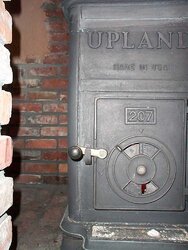I was given this stove - it needs some TLC but seems solid with no cracks. The pipe comes out the back as opposed to from the top. We currently burn two other stoves to supplement our oil heat in upstate NY. We are experienced having used woodstoves since '76. However, our other two stoves are 1897 and 1920's kitchen wood and gas.
This Upland was manufactured from 1979 to 1985 I think. Is it just a conventional woodstove? Does anyone have any experience with it and know of any disadvantages or quirks with it? Any information would be greatly appreciated. Diane
This Upland was manufactured from 1979 to 1985 I think. Is it just a conventional woodstove? Does anyone have any experience with it and know of any disadvantages or quirks with it? Any information would be greatly appreciated. Diane


